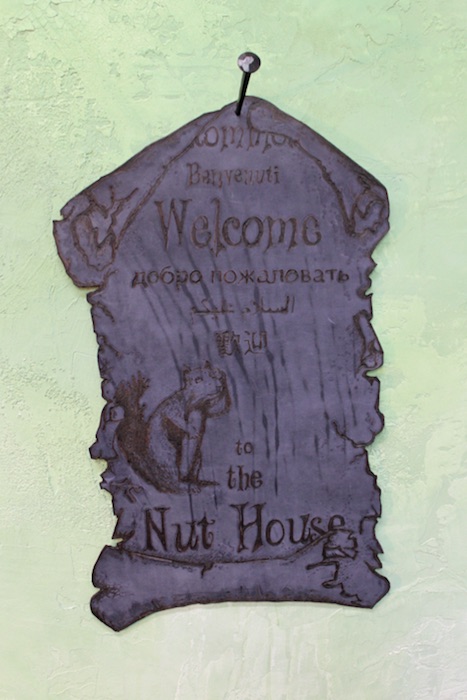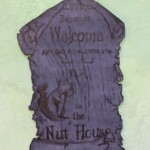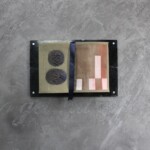Exhibition
in Zürich / Switzerland
- Ilaria Vinci: Plaisir de Recevoir, 2020, leather pyrography, forged iron nail, 51.5 x 33.5 cm
- Brigit Naef: Ghost, 2019, cardboard, metal chains, silver plating, lacquer, 201 x 34 x 10 cm
- Tanja Roscic: Cat Chair, 2020, metal, wood, textile, foam
- Caterina De Nicola: Untitled, 2020, wooden frame, chipboard wood, screws, bricolage varnish, Vitra fabric, starch glue, acrylic paint, fabric medium, puffer paint, printed paper, 46 x 72 x 10 cm
Last Tango is pleased to present “Whispering Walls” an exhibition with new works by Caterina De Nicola, Brigit Naef, Tanja Roscic and Ilaria Vinci.
“Whispering Walls” starts with a premise: Last Tango’s latest relocation to a barn located by the river next to a rail track and a grain elevator. Having at one point in time likely been the repository of the Sullana cigarette factory, the barn is part lifestyle garden center and part creative wall decor showroom. On the second floor, in what was once the showroom, new architectural features, such as lofty windows open the vistas up to the surrounding natural, industrial and urban scapes. A microcosm of sampling the walls are surfaced with gold leaf, plaster handbags, embossed handwritten text as well as “concrete” and “brick.” Left intact for this exhibition, these walls allude to a becoming (Deleuze/Guttari): a “suspended” moment, a not yet there, a potential. A simulation of noble materials, the genuine or aged look, the textures are hypothetically bought with the desire to make a home more “homely,” a cosmopolitan dwelling more cosmopolitan and a business more “businessy.”
Some spider webs and dust that were there upon moving in have also been purposely left untouched. The newly installed Ikea kitchen with its air of standardization is in contrast to the per-request customizable hand-made walls. A treasure chest catalogues A4 samples, possibly reminding us of glossy lifestyle magazines glamorizing the wished-for freedoms of “contemporary living.”
With many sculptural wall and floor pieces “Whispering Walls” stimulates our sense of tactility with surfaces ranging from hyper smooth cardboard, protruding puffer paint, delicate glass beads, burnt leather, splintery household wooden bowls and soft velvet, or representationally through the caress of a kiss or the stomping of shoes. Ideas of the domestic and the ornamental are made present through forms of bricolage or allusion. An adherence to an unmonumental attitude, a humbleness in material choice, or in the artists’ ways of composing or layering is palpable. Instances of re-signification appear throughout, either by imitation, slight irony, overt sentimentality or via a lean towards the imaginary through horror fiction or the use of fairytale animals. What comes about is a desire to pervert, gestures that are not-at-first-glance subversive, but poetically contest certain social values, normalcies and traditional givens.
The exhibition explores how “décor as representation of and substitution for transgressive sexual desires”* can manifest in peculiar ways or aims to perhaps project a view of the home as a means “to reject the stoic solitudes of space as rigid, clean and permanent.”** Caterina De Nicola’s “Untitled” (2020) a sculptural wall object alluding to an open book, features pasted snippets of Ero guro texts written by the artist. These erotico-grostesque tellings depict moments of touch, flesh, fluids, the abject and penetration. Two bulging circles along with a patterned backdrop are in contrast to a vibrantly changing storyline. This element of transgression alludes to concealed fantasies of the psyche, away from clean kitchen top counters and hyper-sanitized interiors.
The abundance of sampling prompts a remark on the precarious condition of the replica reminding us of what Hito Steyerl defines as the poor image: a visual trope which has become overused and depersonalized. Poor images are impoverished relics. Their meaning has been depleted from all its richness and contextual or historical contingency, distilled to the point of being understood immediately. Puppies equal cuteness, gold equals majesty, heart equals love.
In Caterina De Nicola‘s “Untitled” (2020) we stumble upon the image of a yellow heart. It is believed that the heart shape derives from the seed of silphium, an ancient plant that was used by the Greeks and Romans for birth control. The first known depiction of the heart shape as a symbol of love can be traced back to the 1250s where it appeared in a manuscript of a French romance called “Le Roman de la Poire” (The Romance of the Pear) where a kneeling lover offers his heart to a lady. With imprints of shoe soles stepping on the heart’s leather surface, De Nicola’s heart is a rough and exhausted one. A reoccurring image in the artist’s practice, the heart symbol undergoes a clever process of refinement and exhaustion performed on both a material and semantic level. With working procedures that include pushing, piercing and binding the leather is violated. We are called to witness and laugh about the collapse of the institutional symbol of Love.
In Ilaria Vinci‘s pyrographed leather sculptures “Plaisir de Recevoir” (2020) the poor image meets language. We are welcomed to the “Nut House” in brown and blue, colors that are coincidentally reminiscent of the river Limmat facing the space, at times two-colored due to converging waters. A nut house is derogative slang term for the mental asylum. With its ambivalent symbolisms, the home can be a haven to gather energies, be safe and intimate, though can potentially also be a site of uncertainty, negative thought, disorder, hiding or seclusion.
The word “welcome” is written in six different languages, a whimsical merriment of a clichéd expression suggesting vacant hospitality. “Plaisir de Recevoir” is French for “joy of receiving” and brings to mind tact. Tact with its connection to sense and sensitivity has been historically considered a “feminine” power. The not-so-pleasurable 19th century “Cult of Domesticity” prevalent in the U.S. and the U.K. identified the home as the woman’s “proper sphere.” It was a protestant white bourgeois conservative view whereupon “true women” were supposed to possess four cardinal virtues: piety, purity, domesticity, and submissiveness.
Brigit Naef‘s works on the one hand evoke minimalism’s “impersonality” with its attentiveness to reduction, volume, neutral surface and objectivity yet there is something distinctively characterful, flamboyant and seductive in style be it an adornment of frilled glass beads or chains reminiscent of an armor’s chainmail. Imitating surfaces, Naef uses industrial lacquer and silver-plating which produces a hard finish on the cardboard. We are faced with a potpourri of the overt and covert: a toying with the heaviness of modernist sculpture, typically made of industrial products and the blurriness between painting and sculpture/wall objects. The purist forms and shimmering surfaces could also suggest something of the infinite and of the mystical experience.
The floor sculpture “Fleur du Mal” (2016) translated from the French as “Flower of Evil” with its eight leg-like components and signal colors might spur up an image of a spider, Firebird flames or perhaps even Michael Jackson’s black/red leather combo from the 80s. “Millefeuilles” (2017) triggers another wide-ranging set of associations be it Donald Judd’s stacks, a Bauhaus architectural model or a mille-feuille pastry, whereupon its postmodern campiness softens the hard-edged cuboid.
In Tanja Roscic‘s “Faces and Vase” (2020), an almost three-meter long steel structure, two faces discretely appear and lean towards each other for a kiss. The outlines add ornament to a vase and accompany an upholstered velvet cheek, a set of glass tears and a speech bubble. Textural contrasts and sentimental images conjure thoughts of the subconscious and the realm of dreams, love or tenderness. The cushioned surface is a reoccurring feature in Roscic’s practice, oftentimes resembling pin cushions adorned with pins, earrings and knick-knacks. A cluster of narratives are entwined through a constellation of heterogeneous elements in which some relate to the decorative, the homely, fantasy, childhood, and the occult. Made out of worn-out wood workshop table legs, woven baskets, lampshade frames and vintage jump rope handles, these found-object assemblages find aesthetic semblances to protest culture imagery, children illustration, folk art, and the Arts & Crafts movement.
With special thanks to Simone Eugster, Josef Greber, Roman Gysin, Sophie Huguenin, Simon Würsten Marin, Tessa Prati, Marion Richter and Barbara Wespi.
* 106, Faquarson Alex, Cook Roger, Jean Cocteau, “A Provisional Interior in Marc Camille Chaimowicz Zürich Suite” (Zurich: Migros Museum für Gegenwartskunst, 2006), Eds. Marc Chamille Chaimowicz, Heike Munder, Urs Lehni and Lex Trüb. Exhibition catalogue
** 2, Turgeon Alex, “How to Build a Home in a House on Fire”, 2020
Opening hours Fri 3 – 6 pm, Sat 12 – 6 pm, and by appointment
Location:
Last Tango
Sihlquai 274
8005 Zürich
Switzerland





